
Kenneth Platt
Hickam Field, Hawaii
December 7, 1941
Kenneth Platt
Technical Sergeant, U.S. Army
1937–1945

Pvt. Kenneth Platt
Fort San Houston, TX, 1937
That Sunday morning, December 7th, I was asleep when machine gun fire hit the building. We had no idea what was happening.
I grew up in Shawnee Prairie, Texas and went to school through 7th grade. As a kid I picked cotton and worked on a farm. I joined the Army in March, 1937, two months before I turned 16. I went down to the recruiter with a friend; he was 18. The recruiter said I didn’t look 18, but I got in.
I went to recruit training at Fort Sam Houston. It wasn’t boot camp back then. I was assigned to the 24th Infantry Division at Fort Sam. I separated in March, 1940, then re-enlisted and went to Hawaii. That sounded like a good place to go. They put me in the coast artillery and I drove a truck in a motor pool at Fort DeRussy near Waikiki Beach. I had a good friend in the infantry in Hawaii. We talked to his first sergeant, and about a week later I transferred to Schofield Barracks about 10 miles from Pearl Harbor.
That Sunday morning, December 7th, I was asleep when machine gun fire hit the building. We had no idea what was happening. They were bombing Wheeler Field right across the road. They dropped their bombs and held their machine guns down all the way across Schofield. Everything was locked up, and the supply sergeant wasn’t there, so we tore the door off the armory to get to the machine guns. We shot at those airplanes but you couldn’t angle it up very high without a tripod.
After it all settled down, we loaded .30 caliber machine gun ammunition on the lawn. We were still using equipment from WWI. That night we rode blackout patrol off the base. We saw the damage at Pearl from the highway—it was tore all to pieces. Over the next few days, we moved out away from the barracks and stayed in the field almost all of 1942. Next we went to Australia. My platoon leader chose me to go with him to bomb disposal school. We went to Sidney and learned how to identify and get rid of unexploded bombs.
After that, we went to Goodenough Island off of New Guinea. We got in boats and did dry-run combat landings. Then we went to Hollandia in Dutch New Guinea and run the Japanese out. In July, 1944 I had enough points to come home. I got 30 days leave, then I was assigned to basic infantry school at Fort Hood. We trained troops for 12 weeks. In December, 1944 when the Battle of the Bulge was going on, we was on a field exercise out in the woods and got orders to return to base. They were sending over all recruits that had 10 weeks training.
I got out of the Army in October, 1945 as a buck sergeant, and re-enlisted in the Air Force in January, 1946. I was an aircraft mechanic. My brother and I both were at Randolph. He went to Bangor, Maine in a B-26 in bad weather and got killed in a crash on November 15, 1946. I was in the Air Force for 12 years and retired as a tech sergeant.
I opened and ran a service station for two years. Then I owned five coffee shops with a partner who went crooked. I ran coffee shops until 1981, then I sold them and retired. I ain’t done nothing but hunt and fish since then.
My worst day in the military was in New Guinea. There were still Japanese scattered in the hills. We’d go on patrol and I carried a Thompson submachine gun. A friend of mine named Vito Marchesi from Brooklyn was always talking about mowing down the Japanese with it. One day I got tired of hearing him talk and gave him the gun and told him to lead the patrol. We were out about three miles and all hell broke loose. A couple of shots fired and that machine gun cut loose. Then more shots. Marchesi got hit right in the heart. We carried him back and I buried him.
My best day I ever had was when I married that little lady in there on August 4, 1945. We’ve been married over 70 years. {11-12-2015 • San Antonio, TX}